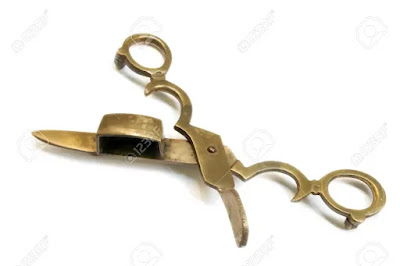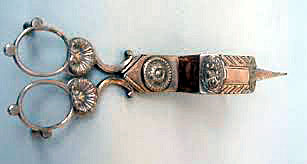
ANSWER: Most people call the bell-shaped cone at the end of a long handle used to put out candles a snuffer. But the device known as a snuffer is actually an “extinguisher” or candle “douter.”


There’s considerable confusion among collectors, antiques dealers and the public concerning the name and function of these little devices known as candle snuffers.
The problem is due to two meanings of the word "snuff." Used as a noun, snuff refers to the burned ash from the spent wick of a candle, but when it's a verb, usually used with the word "out" – then it means to extinguish.
Back in the 18th century, people used snuffers to trim the candlewicks, and to remove the burned snuff, but not to extinguish the candle. At times the flame might have been inadvertently put out in the process, but that wasn’t the intent.
A snuffer was a device made of metal for cutting off, or snuffing, and holding the charred part of a candlewick. Before the invention of the self-consuming wick, around 1830, the hanging burned wick caused the flame to dim, flicker or even go out. Or it may have dropped against the side of the candle, forming a channel or gutter in the precious wax. So it became expedient to reach in with the snuffer to clip the wick and remove the snuff every hour or so.

Craftsmen made all snuffers, douters, and extinguishers of brass, copper, or pewter and elaborately engraved them. They added delicately twisted handles, basket woven cones, or beautifully etched patterns to make the snuffer a beautiful addition to any home.
Besides improving the efficiency of their snuffers, craftsmen began engraving and chasing them with cupids, garlands, leaves and flowers, and sometimes with the monogram of the owner. They used elaborate finishes, such as gilt, enamel, silver plating and even inlaid fancier ones with faience and porcelain.


It may seem strange today that so much effort went into the design and making of simple snuffers and trays. But since candles provided all lighting during the darker hours, it’s easy to see why so much went into care went into these devices. A pattern bock of around 1800 shows 165 different tray designs, and in 1839 a directory of the city of Birmingham, England, listed 30 manufacturers of steel candle snuffers, the plainest kind.
With the invention of the self-consuming candle wick and improved wax, snuffers and their trays became unnecessary. In fact, many people used the snuffer trays as ashtrays when cigar smoking came into vogue during the Victorian Age.
To read more articles on antiques, please visit the Antiques Articles section of my Web site. And to stay up to the minute on antiques and collectibles, please join the over 30,000 readers by following my free online magazine, #TheAntiquesAlmanac. Learn more about the "Antiques of Christmas" in the 2021 Holiday Edition, online now. And to read daily posts about unique objects from the past and their histories, like the #Antiques and More Collection on Facebook.



